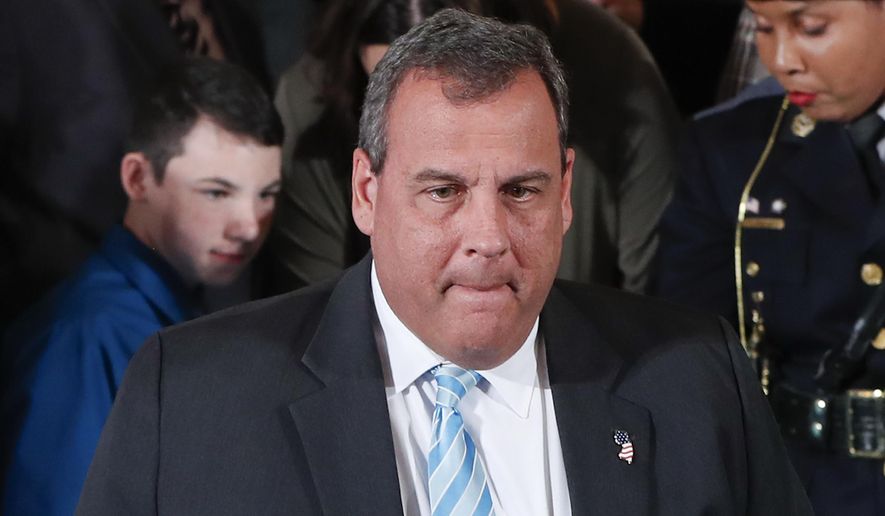New Jersey Gov. Chris Christie says the U.S. finally addressed the HIV/AIDS crisis in the 1980s because affected Americans paraded down the streets of Washington and other major cities, saying it was time for power brokers to take the epidemic seriously.
It’s time to start marching again, he recently told Congress — this time to erase widespread stigma that is holding back the fight against an opioids epidemic that kills about 100 people per day in the U.S.
“We will have seen that we’ve begun to remove the stigma of this disease when the people who are impacted are willing to show their face and march and demand, from their government, a response,” said Mr. Christie, a Republican who led President Trump’s commission on opioids addiction. “They don’t march today because they are ashamed to march, because they don’t want to be identified.”
As federal and state leaders try to catch up with the opioids crisis, analysts say too many people still treat drug addiction as a personal failing instead of a disease and that it’s keeping too many Americans from getting the help they need.
Only 1 in 10 people who need treatment for a substance use disorder are getting it — a ratio that would be unfathomable for conditions such as diabetes or kidney cancer.
While some addicts say they cannot find treatment or afford it, a fifth of those who were not seeking help feared negative opinions from their community, according to a frequently cited survey from 2014.
SEE ALSO: Mark Meadows introduces bill that would limit opioid prescriptions to seven days
They fear they will be blamed for their problems, kicked out of their homes or fired from jobs, public health specialists said.
“All of those things have led them to try and hide their addiction from everyone, until it has become so severe that they end up either in the emergency department or they have an overdose,” said Yngvild Olsen, medical director for the Institutes for Behavior Resources in Baltimore.
Advocates believe the tide is starting to turn, albeit slowly, as affected families see others sharing the same struggles, transcending lines of race, gender and economic status.
“We need to tell more and more stories of successful people who are in recovery. I think society is starting to get it, but I think we need to get more and more stories out there,” said Gary Mendell, CEO of Shatterproof, a nonprofit he founded to erase stigma around the opioids problem and spare families the pain he felt when he lost his son, Brian, to addiction in 2011.
“He did not overdose. Tragically, he took his own life,” Mr. Mendell said. “He hadn’t used a substance in 13 months, but he took his own life. It was all about shame and stigma.”
Mr. Christie’s commission called for a nationwide awareness campaign to focus on the dangers of opioid use and to remove stigma attached to addiction.
Congress is still debating how much funding to devote to the campaign and overall fight, but in the meantime, it is investigating what role opioid manufacturers may have played in aggressively marketing pain pills or downplaying their addictive qualities in the late 1990s and early 2000s.
Many people have become hooked on opioids, unwittingly, after taking prescription pain pills following medical procedures.
“I think that public opinion might start to change as more information comes out about the way drug companies changed medical opinion to encourage opioid treatment for chronic pain, knowing that the risk of addiction was high,” said Richard Ausness, a law professor at the University of Kentucky who tracks the issue. “Even if people are not quite ready to regard drug addicts as victims, they may begin to see drug companies as villains.”
Complicating the matter is the treatment, which often involves using other drugs to kick the main opioid addiction, and the stigma that attaches to that.
Food and Drug Commissioner Scott Gottlieb recently told Congress that patients who rely on medication-assisted treatment shouldn’t feel ashamed.
Addiction specialists say that message needs to resonate in the court system, where judges have been known to order drug defendants off of medication-assisted treatment.
“It’s slowly starting to change, but it’s still more prevalent than it should be,” Dr. Olsen said.
Mr. Mendell said he hopes society at large will treat addiction like any other medical disorder. Just as diabetes patients need insulin to control their blood sugar, he said, people with substance use disorders may need drugs such as buprenorphine to deal with addiction.
Years ago, people in recovery would tell Mr. Mendell that they couldn’t dare show up to public events about drug addiction, saying they could lose their jobs or miss out on promotions if they outed themselves as in recovery.
But this year, Shatterproof scheduled 5K runs to “rise up against addiction” in cities across America. Mr. Mendell said the events attracted an average of 1,800 people — proving it’s possible to hit the streets, like Mr. Christie prescribed, while responding to his son’s final plea.
“I wish people would understand, I’m not a bad person,” Brian told him shortly before he died. “I’m a good person with a bad disease, and I’m trying my absolute hardest.”
• Tom Howell Jr. can be reached at thowell@washingtontimes.com.




Please read our comment policy before commenting.